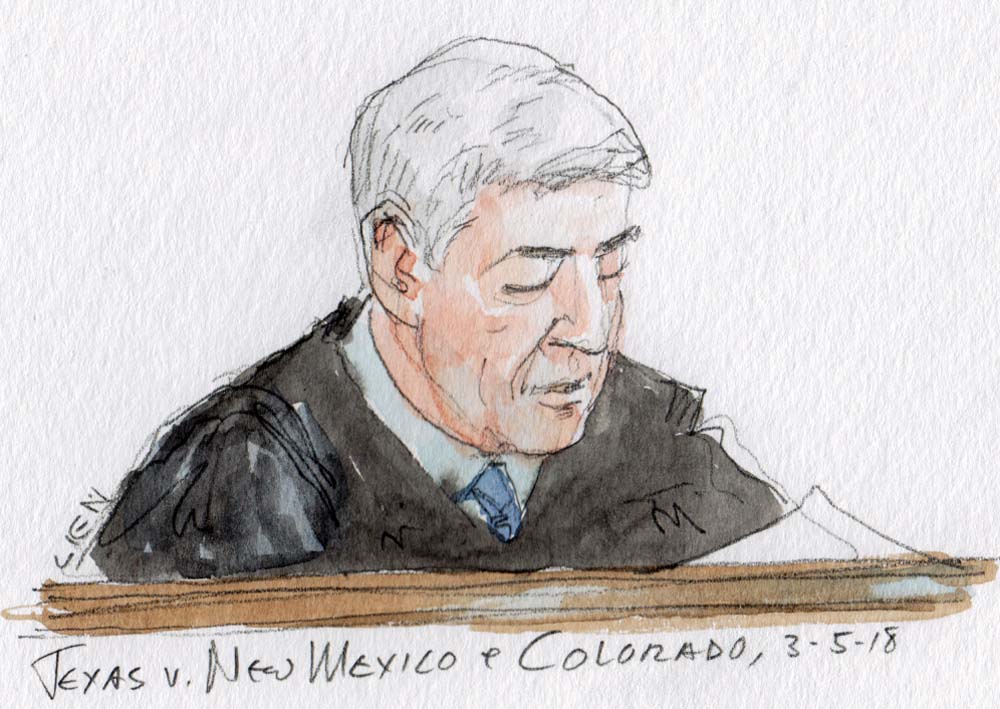Opinion analysis: Texas’ compact claims against New Mexico over the Rio Grande River leave room for United States’ claims as well
on Mar 5, 2018 at 6:43 pm

Texas sued New Mexico claiming that New Mexico had breached the Rio Grande Compact, and the United States agreed, alleging that New Mexico’s breaches harmed the United States’ interests on the Rio Grande River as well. New Mexico’s argument that the United States was not a party to the Rio Grande Compact carried water with the special master appointed to hear the case. But today the Supreme Court rejected New Mexico’s arguments in a unanimous opinion by Justice Neil Gorsuch, holding that the United States’ arguments about federal interests were compelling, if relatively unusual. Cautioning that permission was not license, the court allowed the United States’ claims to move along on the Rio Grande.

Justice Gorsuch with opinion in Texas v. New Mexico and Colorado (Art Lien)
This term’s Rio Grande River decision covers a preliminary proceeding in the original-jurisdiction water dispute between Texas, New Mexico and Colorado over the flows of the river. A 1906 treaty between Mexico and the United States guaranteed that 60,000 acre feet of water would be delivered to Mexico annually. This was to be accomplished through the operations of the Elephant Butte reservoir, constructed about a decade after the treaty was signed. Additional water from the Elephant Butte reservoir beyond the 60,000 acre feet due to Mexico was sold by the United States Bureau of Reclamation to irrigation districts in Texas and New Mexico. The Rio Grande Compact further apportioned water rights among Texas, New Mexico and Colorado with congressional approval in 1939.
In 2014, the Supreme Court granted Texas’ motion for leave to file a complaint, and the United States filed a complaint in intervention against New Mexico as well. The United States’ complaint in intervention asserted jurisdiction under both 28 U.S.C. § 1251(b)(2) and Article III, Section 2, Clause 2 of the United States Constitution. New Mexico moved to dismiss the United States’ complaint. The Supreme Court’s appointed special master, A. Gregory Grimsal, has been working through preliminary aspects of the litigation. The special master noted that the United States is not typically a party in interstate disputes, appearing as an amicus if at all. He referenced the occasional exceptional case in which the United States is allowed to intervene to protect unique sovereign interests. The special master also made further recommendations on other interventions and motions.
On October 10, 2017, the Supreme Court denied New Mexico’s motion to dismiss Texas’ complaint and denied intervention motions by the two local water entities. The exception of the United States and the first exception of Colorado to the first interim report of the special master were set for oral argument, and those matters were heard on January 8, as part of an interstate-apportionment double header. The only aspects of the Rio Grande dispute considered at this stage were the exceptions taken to the first interim report by the United States and Colorado.
Citing to Will Rogers, the Supreme Court noted that the Rio Grande may be the only river that could benefit from irrigation. The court made quick work of New Mexico’s primary argument. Reasoning that the role of the federal government in resolving disputes under the Constitution’s compact clause is to serve as a substitute for diplomacy between sovereigns, the court referenced its recent opinion on the Republican River. But the Rio Grande opinion carefully cautioned that “just because Congress enjoys a special role in approving interstate agreements, it does not necessarily follow that the United States has blanket authority to intervene in cases concerning the construction of those agreements.”
To support the holding, the court pointed to four key factors. First, the United States’ claims under the compact are “inextricably intertwined” with the Rio Grande Project and the contracts with downstream users at the heart of Texas’ complaint. Second, New Mexico conceded that the United States is an indispensable party to the complaint because of its role in delivering the compact’s water to the parties to this dispute. Third, any breach of the compact could impair the ability of the United States to meet its treaty obligations to deliver 60,000 acre feet to Mexico.
Lastly, and perhaps most importantly, the United States has sought to bring these claims in a complaint filed by Texas under the compact and seeking essentially the same relief. The Supreme Court explicitly stated that whether the United States could sue a state directly for violations of the compact is still an open question. At oral argument, in response to questioning by Justice Elena Kagan, Assistant to the Solicitor General Ann O’Connell had committed the United States to the position that it could file its own suit against New Mexico under the compact, irrespective of Texas’ claims. Additionally, Chief Justice John Roberts pressed O’Connell about whether Congress could have required such power as a condition of its approval of a compact. Those questions are left to be resolved in another case. For now, the dispute over the Rio Grande goes back before the special master for further proceedings on the merits. At stake are billions of gallons of water for agricultural use and international agreements. Texas’ boots are large enough to hold Uncle Sam as well.


